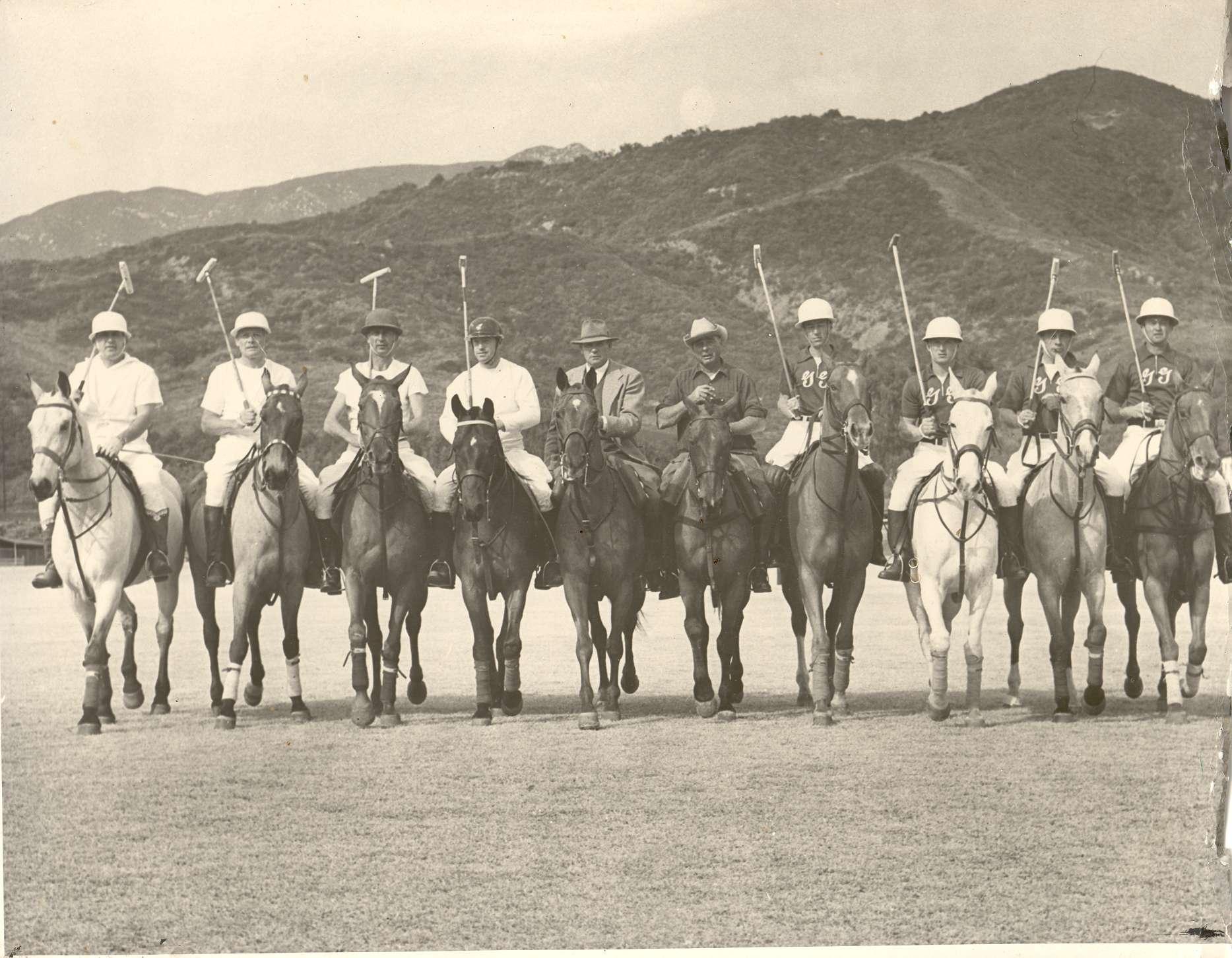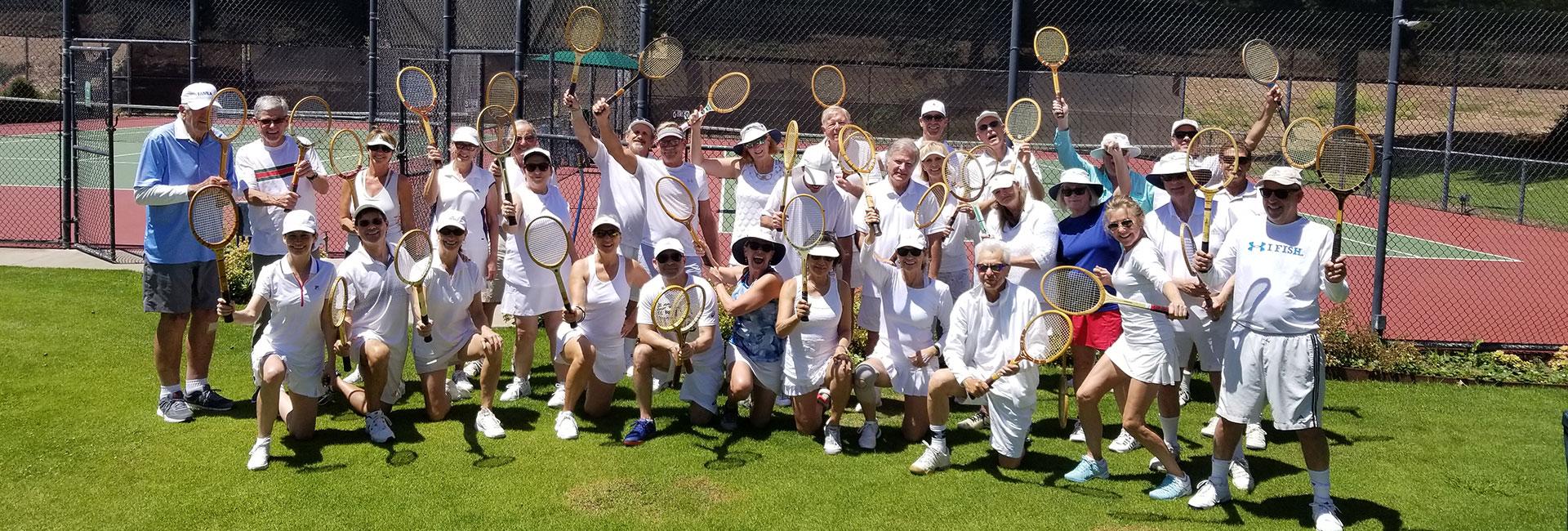Santa Barbara Polo Club is History Overview:
An exhibition polo match was first played at the Santa Barbara Agricultural Park’s 1894 Flower Festival. This match encouraged sufficient local interest in the sport that by 1902, the fledgling Club boasted a 40-member roster. Polo flourished within the community as various fields emerged, thereby drawing players to the area.
A fire in Carpinteria in 1916 incidentally paved a way for what was later called Fleischmann Field. In 1926 the club was sold to Major Fleischmann, who had an architect, Robert Spurgeon, design the barns and the polo clubhouse. Nearby Summerland beach became a favorite training ground for the players who ran their ponies through surf and sand.

The late ‘20’s and the mid ‘30’s saw the Santa Barbara Polo Club into its golden era. Teams, horses, and players would arrive by train, unload from the stock cars, and walk through downtown Santa Barbara all the way to the Club. Sundays at the Club became a great social event in this era. Spectators gathered to view the sport dressed in the finest and latest of fashions and picnicked at the fields with large blankets and staff to serve the noon day meal. The games were riveting, fast and furious. Players graced the fields while guests enjoyed the players’ skills, basked in the mountain views, and were lulled by the sounds of the nearby ocean.
In February of 1942, there was an unexpected suspension of polo. The first enemy bombardment on American soil since the War of 1812 occurred in nearby Goleta. Near Senator Tom Storkes’ ranch, a Japanese submarine attempted to knock out a large oil storage tank close to the beach. Twenty-five shells in all were fired, but none hit their target. The community, understandably, put all its energy into the war effort and, through 1946, the Club’s polo fields were used to station and train soldiers. During these four years, the soldiers trained so extensively that the fields became bare. The fields required much renovation before they could be used again for polo and the war had such lasting effects that only the staunchest supporters played.
The 1950’s brought renewed interest in the sport as several avid polo families moved to the area. Polo once again thrived at the Club. The success lead to the U.S. Open tournament being played here in 1963 and 1966. The owner at the time, Rudy Tong, was able to secure participants by many impressive foreign teams.
The 1970's saw the arrival of yet more polo families and in 1974 the Club was renovated to encourage a new renaissance in polo. This included 141 deluxe condominium units, 2 swimming pools, a Jacuzzi, eight tennis courts, a tennis clubhouse, an exercise track for the horses, an arena, stabling for 350 horses, and three turf fields. The original clubhouse was left intact. During the 1980's, the Club developed multiple leagues of polo to attract new players at various skill levels. This has ensured continued polo enthusiasm to this day and continues to encourage future players through the promotion of intercollegiate polo, public polo lessons and creative marketing. On the social side, the Club is reputed for its parties, elegant events and fine dining during the polo season and year-round, the Club's tennis, swim and fitness members enjoy a social scene too.
TIMELINE
1894: Polo game played in Santa Barbara at the Agricultural Park as an Exhibition.
1902: Santa Barbara Polo Club boasted a 40 man roster.
1911: Santa Barbara Polo Club was admitted to the United States Polo Association (USPA).
1916: Fire tore through Carpinteria, the future site of the Santa Barbara Polo Club (SBPC)
1923: Major Max Fleischmann, "the yeast king", purchased the current site from J.D. Nidever.
1929: Fleischmann acquired adjoining forty acre parcel to the SBPC. Began placing "stollons" of Bermuda grass
1920's & 30's: Saw a rise of polo at SBPC. Teams and their horses would arrive by train box car being unloaded and walked from the train station to the stables at the SBPC. During this time, the spectators would bring their box lunches and sit on the side of the fields and enjoy the games being played in the afternoon.
1933: the SBPC was officially incorporated by the state of California.
1936: Major Fleischmann divided the SBPC into ten parts for the sum of ten dollars. He sold 5 parts, for $1 each.



TIMELINE
1894: Polo game played in Santa Barbara at the Agricultural Park as an Exhibition.
1902: Santa Barbara Polo Club boasted a 40 man roster.
1911: Santa Barbara Polo Club was admitted to the United States Polo Association (USPA).
1916: Fire tore through Carpinteria, the future site of the Santa Barbara Polo Club (SBPC)
1923: Major Max Fleischmann, "the yeast king", purchased the current site from J.D. Nidever.
1929: Fleischmann acquired adjoining forty acre parcel to the SBPC. Began placing "stollons" of Bermuda grass

1920's & 30's: Saw a rise of polo at SBPC. Teams and their horses would arrive by train box car being unloaded and walked from the train station to the stables at the SBPC. During this time, the spectators would bring their box lunches and sit on the side of the fields and enjoy the games being played in the afternoon.
1933: the SBPC was officially incorporated by the state of California.
1936: Major Fleischmann divided the SBPC into ten parts for the sum of ten dollars. He sold 5 parts, for $1 each.
1937: Harry East became the new Polo Manager of SBPC.
1939: Robert Skene first visited the SBPC. He immediately fell in love with the club only to return later to support the SBPC with his ability of 10 goals. He returned to manage the club during the economic turndown of the 1970's. Mr. Skene is also remembered for locating and acquiring the famed Pacific Coast Open Trophy.
WWII suspended polo throughout the world. There was an attack by Japan in Goleta. 25 shells were fired from a Japanese submarine but none hit their oil storage target.
1946: Soldiers were placed at the SBPC for the remainder of the War. The grass fields became bare as they were used as barracks for the troops. Following WWII, only the wealthy could begin to play again and could afford to refurbish the polo fields.
1950's: Arrival of the Polo Families
1954: Harry East retired as the Polo Manager and the Harry East tournamened was names in his honor.
1960: The ultimate return of Robert Skene.
1963 & 1966: The prestigious U.S. Open Tournament was played at the SBPC. SBPC also hosted the first U.S. team trials for the famous Argenia vs. U.S. match in Buenos Aires.

1960's - 1970's: The club experienced many owners consisting of the Tongg Family, American Finance Limited and the Azusa Foothill Citus.
1970: Arrival of the Polo Families:
1976: Lesile Nixon accepted the Polo Manger position. He died in 1977 while playing polo. He was greatly respected and a trophy was named after him in 1978.
Development of a new quarter mile horse exercise track, barns and stabling, 8 tennis courts, a tennis clubhouse, and a recreational pool.
1980: SBPC held a new tournament after the death of Vic Graber in his honor. He was well known for the support of polo and to the teams that he brought to SBPC.
1986: Santa Barbara Polo Club celebrated its 75th Anniversary.
1999: The number of polo games played has increased by 104%.
2007: Mr. Norman Ringer, M.D. served as an active Trustee of the Santa Barbara Polo & Racquet Club for over 35 years, passed away.
2008: Ms. Melanja Jones became the first female Polo Manager at the Club.
2008: Mrs. Ariana Rothstein-Fisch Nobel became the first female General Manager at the Club.

2011: Mr. & Mrs. Daniel Walker completed a fully functional scoreboard on Field 3.
2011: Santa Barbara Polo & Racquet Club celebrated its Cenntennial year. On July 9th, the club had a historical visit by Prince William & Kate, Duke & Dutchess of Cambridge, for the Foundation Polo Challenge charity event.
2019: Santa Barbara Polo & Racquet Club hosted its first ever Women's Pacific Coast Open tournament.
1960's - 1970's: The club experienced many owners consisting of the Tongg Family, American Finance Limited and the Azusa Foothill Citus.
1970: Arrival of the Polo Families
The Conants, The Holdens, The Ringers

